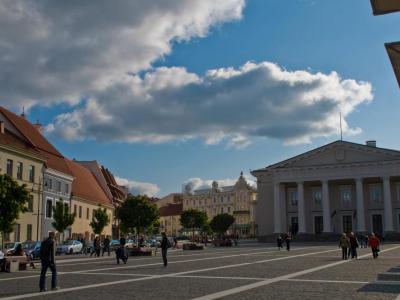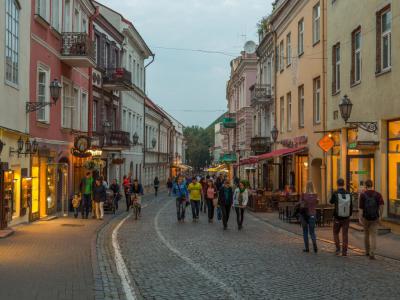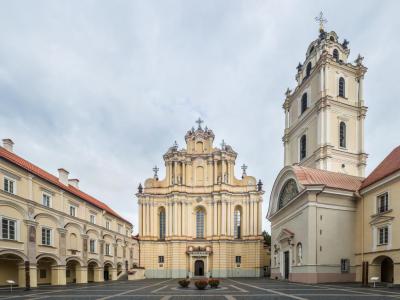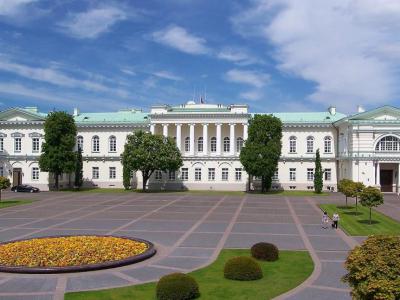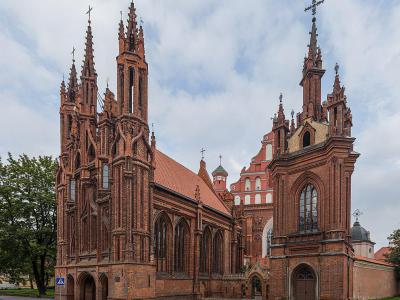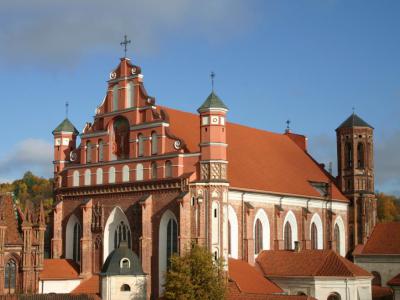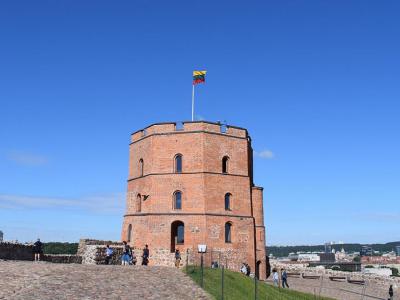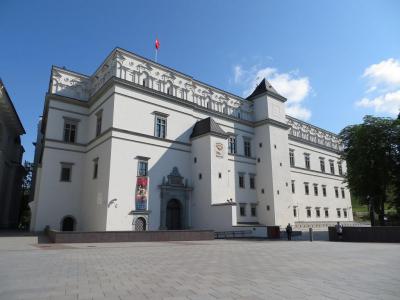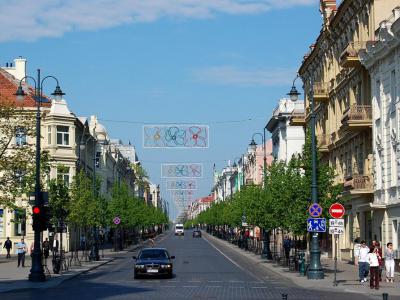Audio Guide: Vilnius Old Town Walking Tour (Self Guided), Vilnius
Legend has it that Grand Duke Gediminas dreamed of an iron wolf howling on a hill, inspiring him to found a city that would grow into today’s Vilnius. Centuries later, in 1812, when Napoleon passed through Vilnius during his Russian campaign, he reportedly described the city as “a pearl of the north, full of charm and surprises.”
Vilnius, the capital of Lithuania, is one of Eastern Europe’s oldest and most picturesque cities. Its name comes from the nearby Vilnia River, believed to derive from the Lithuanian word vilnis, meaning “wave” or “ripple,” reflecting the river’s flowing character and the city’s dynamic spirit.
The city’s origins trace back to the early 14th century, when Grand Duke Gediminas established his residence at the confluence of the Neris and Vilnia rivers. In 1323, he famously invited European merchants and craftsmen to settle in Vilnius, promising protection and religious freedom. This marked the beginning of the city’s rise as a thriving, multicultural hub at the crossroads of trade between Western and Eastern Europe.
By the 15th century, Vilnius had become the political and cultural heart of the Grand Duchy of Lithuania. Its skyline grew rich with Gothic churches, Renaissance palaces, and later Baroque masterpieces. The founding of Vilnius University in 1579—the oldest in Eastern Europe—further established the city as a center of learning and intellectual life.
The late 18th and 19th centuries brought major changes. After the partitions of the Polish–Lithuanian Commonwealth, Vilnius fell under Russian rule, which suppressed its Lithuanian identity. Despite these challenges, the city remained a cultural beacon. In the 20th century, it endured occupations by Poland, Nazi Germany, and the Soviet Union, before finally reclaiming its status as the capital of an independent Lithuania in 1990.
Today, Vilnius is celebrated for its beautifully preserved Old Town, a UNESCO World Heritage Site. Walking through its cobblestone streets, visitors encounter colorful Baroque façades, hidden courtyards, and lively squares. Highlights include the majestic Vilnius Cathedral and its bell tower, the ornate St. Anne’s Church, and the bustling Pilies Street lined with cafés, galleries, and boutiques. Medieval gates, quaint alleyways, and vibrant street performers create an immersive experience where history and everyday life intertwine.
As you wander through the streets of Vilnius Old Town, it’s easy to imagine Gediminas’ iron wolf howling on that hill and to feel the energy Napoleon once admired. The city continues to surprise and captivate, proving that this “pearl of the north” still lives up to its legendary beginnings.
Vilnius, the capital of Lithuania, is one of Eastern Europe’s oldest and most picturesque cities. Its name comes from the nearby Vilnia River, believed to derive from the Lithuanian word vilnis, meaning “wave” or “ripple,” reflecting the river’s flowing character and the city’s dynamic spirit.
The city’s origins trace back to the early 14th century, when Grand Duke Gediminas established his residence at the confluence of the Neris and Vilnia rivers. In 1323, he famously invited European merchants and craftsmen to settle in Vilnius, promising protection and religious freedom. This marked the beginning of the city’s rise as a thriving, multicultural hub at the crossroads of trade between Western and Eastern Europe.
By the 15th century, Vilnius had become the political and cultural heart of the Grand Duchy of Lithuania. Its skyline grew rich with Gothic churches, Renaissance palaces, and later Baroque masterpieces. The founding of Vilnius University in 1579—the oldest in Eastern Europe—further established the city as a center of learning and intellectual life.
The late 18th and 19th centuries brought major changes. After the partitions of the Polish–Lithuanian Commonwealth, Vilnius fell under Russian rule, which suppressed its Lithuanian identity. Despite these challenges, the city remained a cultural beacon. In the 20th century, it endured occupations by Poland, Nazi Germany, and the Soviet Union, before finally reclaiming its status as the capital of an independent Lithuania in 1990.
Today, Vilnius is celebrated for its beautifully preserved Old Town, a UNESCO World Heritage Site. Walking through its cobblestone streets, visitors encounter colorful Baroque façades, hidden courtyards, and lively squares. Highlights include the majestic Vilnius Cathedral and its bell tower, the ornate St. Anne’s Church, and the bustling Pilies Street lined with cafés, galleries, and boutiques. Medieval gates, quaint alleyways, and vibrant street performers create an immersive experience where history and everyday life intertwine.
As you wander through the streets of Vilnius Old Town, it’s easy to imagine Gediminas’ iron wolf howling on that hill and to feel the energy Napoleon once admired. The city continues to surprise and captivate, proving that this “pearl of the north” still lives up to its legendary beginnings.
How it works: Download the app "GPSmyCity: Walks in 1K+ Cities" from Apple App Store or Google Play Store to your mobile phone or tablet. The app turns your mobile device into a personal tour guide and its built-in GPS navigation functions guide you from one tour stop to next. The app works offline, so no data plan is needed when traveling abroad.
Vilnius Old Town Walking Tour Map
Guide Name: Vilnius Old Town Walking Tour
Guide Location: Lithuania » Vilnius (See other walking tours in Vilnius)
Guide Type: Self-guided Walking Tour (Sightseeing)
# of Attractions: 11
Tour Duration: 2 Hour(s)
Travel Distance: 4.5 Km or 2.8 Miles
Author: emily
Sight(s) Featured in This Guide:
Guide Location: Lithuania » Vilnius (See other walking tours in Vilnius)
Guide Type: Self-guided Walking Tour (Sightseeing)
# of Attractions: 11
Tour Duration: 2 Hour(s)
Travel Distance: 4.5 Km or 2.8 Miles
Author: emily
Sight(s) Featured in This Guide:
- Town Hall and Town Hall Square
- Pilies Street (Castle Street)
- Vilnius University
- Presidential Palace
- St. Anne's Church
- Bernardine Church
- Gediminas Tower
- Palace of the Grand Dukes of Lithuania
- Vilnius Cathedral
- Gediminas Avenue
- KGB Museum
1) Town Hall and Town Hall Square
Vilnius has had a town hall since 1432. The first one was Gothic, but over the centuries it was rebuilt several times. The well-known Lithuanian architect Laurynas Gucevičius, who studied in France, designed the current version after the old one collapsed. Completed in 1799, it’s a fine example of neoclassical architecture and one of Gucevičius’s greatest works—alongside Vilnius Cathedral and the bishops’ summer palace in Verkiai.
For centuries, the Town Hall was the center of civic life. It served as a theatre, hosted the city’s first opera performance, and housed the merchants’ society, shops, the treasury, and even a prison. Today, it continues to be a lively cultural venue for exhibitions, concerts, and official events. Visitors can also explore the Town Hall’s underground catacombs, where traces of the city’s early history remain.
Outside, the spacious Town Hall Square is a favorite meeting place for locals and visitors alike. Once the site of markets, performances, and public punishments, it’s now used for fairs and celebrations. In winter, it sparkles with a giant Christmas tree, while in summer, people gather by the illuminated fountain. Around the square, you can spot Vilnius’s coat of arms—St. Christopher carrying the Christ Child—symbolizing protection and endurance.
For centuries, the Town Hall was the center of civic life. It served as a theatre, hosted the city’s first opera performance, and housed the merchants’ society, shops, the treasury, and even a prison. Today, it continues to be a lively cultural venue for exhibitions, concerts, and official events. Visitors can also explore the Town Hall’s underground catacombs, where traces of the city’s early history remain.
Outside, the spacious Town Hall Square is a favorite meeting place for locals and visitors alike. Once the site of markets, performances, and public punishments, it’s now used for fairs and celebrations. In winter, it sparkles with a giant Christmas tree, while in summer, people gather by the illuminated fountain. Around the square, you can spot Vilnius’s coat of arms—St. Christopher carrying the Christ Child—symbolizing protection and endurance.
2) Pilies Street (Castle Street)
Castle Street, known locally as Pilies Street, is one of the most vibrant and historic streets in Vilnius Old Town. Stretching between Cathedral Square and Town Hall Square, it has long been the beating heart of the city’s cultural life. Today, it’s alive with the rhythm of street performers, local artisans, and the hum of conversations drifting from cozy cafés and shops.
The street’s lively market atmosphere draws both locals and visitors. Folk artists from across Lithuania come here to sell their handmade crafts, from delicate linen clothing to gleaming amber jewelry—perfect souvenirs of a visit to Vilnius. Every March, the street bursts into color during the Kaziukas Fair, one of the city’s oldest and most beloved folk festivals, when artisans fill the street with music, crafts, and traditional treats.
Throughout the year, Castle Street is also a focal point for celebrations. It becomes a festive promenade during Christmas and Easter, as well as on March 11, the Day of the Restoration of Independence. When Lithuania’s basketball team wins a major game, joyful processions often spill down this same street, echoing with cheers and song.
Castle Street is also steeped in history. First mentioned in 1530, it is the oldest street in Vilnius, lined with an architectural mix of Gothic, Renaissance, and Baroque buildings.
Notable landmarks on Pilies Street include the House of the Signatories, where the Declaration of Independence was signed in 1918, and Vilnius University's headquarters. The university occupied a quarter of the city beside Pilies Street, and its professors used to live there. The street is also home to St. John's Church, which has a beautiful Baroque pediment and offers a stunning view of Gediminas Tower.
The street’s lively market atmosphere draws both locals and visitors. Folk artists from across Lithuania come here to sell their handmade crafts, from delicate linen clothing to gleaming amber jewelry—perfect souvenirs of a visit to Vilnius. Every March, the street bursts into color during the Kaziukas Fair, one of the city’s oldest and most beloved folk festivals, when artisans fill the street with music, crafts, and traditional treats.
Throughout the year, Castle Street is also a focal point for celebrations. It becomes a festive promenade during Christmas and Easter, as well as on March 11, the Day of the Restoration of Independence. When Lithuania’s basketball team wins a major game, joyful processions often spill down this same street, echoing with cheers and song.
Castle Street is also steeped in history. First mentioned in 1530, it is the oldest street in Vilnius, lined with an architectural mix of Gothic, Renaissance, and Baroque buildings.
Notable landmarks on Pilies Street include the House of the Signatories, where the Declaration of Independence was signed in 1918, and Vilnius University's headquarters. The university occupied a quarter of the city beside Pilies Street, and its professors used to live there. The street is also home to St. John's Church, which has a beautiful Baroque pediment and offers a stunning view of Gediminas Tower.
3) Vilnius University
Vilnius University is one of the oldest and most distinguished universities in the Baltic region. It was founded in 1579 by Grand Duke Stephen Bathory, originally as the Jesuit Academy of Vilnius. Since then, it has remained a cornerstone of Lithuania’s academic and cultural life.
Throughout history, the university has mirrored the fortunes of the nation. It was closed during wars and occupations, including the Polish–Russian War of 1830–1831 and both World Wars, but reopened each time as a renewed symbol of resilience. After Lithuania regained independence in 1990, Vilnius University reclaimed its status as a leading center of learning and research.
The architectural ensemble of Vilnius University is remarkable, blending Gothic, Renaissance, Baroque, and Neoclassical styles. The complex includes 13 courtyards, each with unique character and history. The Grand Courtyard, with its arcades and memorial plaques, honors the university’s founders and scholars.
The university library, founded in 1570, is one of the oldest and most valuable in Eastern Europe. It houses more than five million items, including one of only two surviving copies of the first Lithuanian book, the Catechism of Martynas Mažvydas, printed in Königsberg (now Kaliningrad, Russia) in 1547.
Within the university complex stands St. John’s Church, a magnificent Baroque building rebuilt in 1749. Visitors can climb its 193 wooden steps, or take the elevator, to enjoy breathtaking views of Vilnius Old Town.
Throughout history, the university has mirrored the fortunes of the nation. It was closed during wars and occupations, including the Polish–Russian War of 1830–1831 and both World Wars, but reopened each time as a renewed symbol of resilience. After Lithuania regained independence in 1990, Vilnius University reclaimed its status as a leading center of learning and research.
The architectural ensemble of Vilnius University is remarkable, blending Gothic, Renaissance, Baroque, and Neoclassical styles. The complex includes 13 courtyards, each with unique character and history. The Grand Courtyard, with its arcades and memorial plaques, honors the university’s founders and scholars.
The university library, founded in 1570, is one of the oldest and most valuable in Eastern Europe. It houses more than five million items, including one of only two surviving copies of the first Lithuanian book, the Catechism of Martynas Mažvydas, printed in Königsberg (now Kaliningrad, Russia) in 1547.
Within the university complex stands St. John’s Church, a magnificent Baroque building rebuilt in 1749. Visitors can climb its 193 wooden steps, or take the elevator, to enjoy breathtaking views of Vilnius Old Town.
4) Presidential Palace
The Presidential Palace in Vilnius has a long and significant history. First constructed in the 14th century, it has undergone multiple enlargements and renovations over the centuries.
In the 16th century, it served as the residence of the bishops of Vilnius. After major fire damage in 1737 and 1748, architect Laurynas Gucevičius supervised its reconstruction around 1750. When Lithuania became part of the Russian Empire in the late 18th century, the palace was turned into the residence of the Governor-General of Vilnius.
Over time, it welcomed several notable figures, including Russian Tsar Alexander I, Emperor Napoleon Bonaparte, and Louis XVIII of France during his exile in 1804.
Between 1824 and 1834, the building was remodeled in the Empire architectural style, with St. Petersburg architect Vasily Stasov overseeing the project. Today, it serves as the official office of the President of Lithuania, and the presidential flag is raised when the President is present.
A daily changing of the guard can be observed in front of the palace. Each Sunday at 12:00 PM, a more ceremonial event takes place, featuring both modern and medieval uniforms and the formal flag-hoisting.
In the 16th century, it served as the residence of the bishops of Vilnius. After major fire damage in 1737 and 1748, architect Laurynas Gucevičius supervised its reconstruction around 1750. When Lithuania became part of the Russian Empire in the late 18th century, the palace was turned into the residence of the Governor-General of Vilnius.
Over time, it welcomed several notable figures, including Russian Tsar Alexander I, Emperor Napoleon Bonaparte, and Louis XVIII of France during his exile in 1804.
Between 1824 and 1834, the building was remodeled in the Empire architectural style, with St. Petersburg architect Vasily Stasov overseeing the project. Today, it serves as the official office of the President of Lithuania, and the presidential flag is raised when the President is present.
A daily changing of the guard can be observed in front of the palace. Each Sunday at 12:00 PM, a more ceremonial event takes place, featuring both modern and medieval uniforms and the formal flag-hoisting.
5) St. Anne's Church (must see)
St. Anne’s Church is a well-known landmark in Vilnius, located on the left bank of the Vilnia River. This Roman Catholic church is admired for its impressive Flamboyant and Brick Gothic architecture and is one of the important monuments that contributed to Vilnius Old Town being included on the UNESCO World Heritage List.
The site’s first church, a wooden structure, was built in 1394 for German Catholics and other foreign visitors. While a legend connects it to Anna, Grand Duchess of Lithuania, who was a known benefactor, historical evidence suggests the church was not originally built specifically for her. After the wooden church was destroyed by fire in 1419, King of Poland and Grand Duke of Lithuania Alexander I Jagiellon commissioned the construction of the current brick church between 1495 and 1500. Its exterior has remained virtually unchanged since that time.
According to local legend, Emperor Napoleon was so captivated by the church during his 1812 campaign that he wished he could carry it back to Paris “in the palm of his hand.” The story has become part of Vilnius’ folklore, reflecting the deep admiration this elegant structure continues to inspire.
The church’s facade is a masterpiece of balance and rhythm, combining pointed Gothic arches with rectangular frames and vertical lines that create a sense of graceful movement. Built from 33 different types of clay bricks, the red-brick surface shimmers beautifully in the sunlight. Inside, the simpler Baroque interior, redesigned in 1749, contrasts with the richly detailed exterior, offering a calm and contemplative space for worship.
A neo-Gothic bell tower, added in the 1870s, complements the church’s architecture and completes this harmonious ensemble. Today, St. Anne’s Church remains one of the finest symbols of Vilnius—an enduring blend of legend, artistry, and faith that continues to enchant visitors, just as it once captivated Napoleon himself.
The site’s first church, a wooden structure, was built in 1394 for German Catholics and other foreign visitors. While a legend connects it to Anna, Grand Duchess of Lithuania, who was a known benefactor, historical evidence suggests the church was not originally built specifically for her. After the wooden church was destroyed by fire in 1419, King of Poland and Grand Duke of Lithuania Alexander I Jagiellon commissioned the construction of the current brick church between 1495 and 1500. Its exterior has remained virtually unchanged since that time.
According to local legend, Emperor Napoleon was so captivated by the church during his 1812 campaign that he wished he could carry it back to Paris “in the palm of his hand.” The story has become part of Vilnius’ folklore, reflecting the deep admiration this elegant structure continues to inspire.
The church’s facade is a masterpiece of balance and rhythm, combining pointed Gothic arches with rectangular frames and vertical lines that create a sense of graceful movement. Built from 33 different types of clay bricks, the red-brick surface shimmers beautifully in the sunlight. Inside, the simpler Baroque interior, redesigned in 1749, contrasts with the richly detailed exterior, offering a calm and contemplative space for worship.
A neo-Gothic bell tower, added in the 1870s, complements the church’s architecture and completes this harmonious ensemble. Today, St. Anne’s Church remains one of the finest symbols of Vilnius—an enduring blend of legend, artistry, and faith that continues to enchant visitors, just as it once captivated Napoleon himself.
6) Bernardine Church
The Church of Saint Francis and Saint Bernard, also known as the Bernardine Church, is a Roman Catholic church located right next to Saint Anne’s Church. Dedicated to Saints Francis of Assisi and Bernardino of Siena, it stands as one of Lithuania’s most important examples of Gothic architecture.
Following their arrival in Vilnius, the Bernardine monks first built a wooden church in the second half of the 15th century, followed by a brick structure at the end of the century. In the early 16th century, the church was reconstructed and integrated into Vilnius’ defensive walls. Later, Renaissance and Baroque elements were added during the 17th and 18th centuries, giving the church its rich architectural character.
The Bernardine Church is notably larger than the nearby Saint Anne’s Church—a reflection of a local legend that the monks’ sermons were so compelling that they drew large crowds, necessitating a bigger building.
During the Soviet era, the church was closed and repurposed as an art institute, before reopening for worship in 1994. The church houses early 16th-century mural paintings, unique for combining Renaissance composition and subject matter with Gothic stylistics, making them a rare artistic treasure in the world.
Following their arrival in Vilnius, the Bernardine monks first built a wooden church in the second half of the 15th century, followed by a brick structure at the end of the century. In the early 16th century, the church was reconstructed and integrated into Vilnius’ defensive walls. Later, Renaissance and Baroque elements were added during the 17th and 18th centuries, giving the church its rich architectural character.
The Bernardine Church is notably larger than the nearby Saint Anne’s Church—a reflection of a local legend that the monks’ sermons were so compelling that they drew large crowds, necessitating a bigger building.
During the Soviet era, the church was closed and repurposed as an art institute, before reopening for worship in 1994. The church houses early 16th-century mural paintings, unique for combining Renaissance composition and subject matter with Gothic stylistics, making them a rare artistic treasure in the world.
7) Gediminas Tower (must see)
Gediminas Tower is one of Vilnius’ most iconic landmarks, visible from many points across the city. The tower appears on old Lithuanian currency and is celebrated in folk songs and poems. It stands on the site of the Upper Castle, a fortress that originally existed as a wooden structure in the 14th century. According to legend, Grand Duke Gediminas dreamed of an iron wolf howling atop the hill, interpreted as a sign that a great city would rise there—Vilnius.
The first brick castle was completed in 1409 by Gediminas’ grandson, Grand Duke Vytautas the Great. Today, Gediminas Tower is the only visible remnant of the original castle, though archaeological remains of the fortifications can still be found on the hill. The tower served multiple purposes over the centuries, including housing Vilnius’ first telegraph station in 1838.
The top floors of the tower had been dismantled during the 19th century under Russian rule, and the current three-story tower was rebuilt in the 20th century, with Polish architect Jan Borowski overseeing restoration work during the interwar period.
Gediminas Tower is now part of the National Museum of Lithuania. The museum showcases Vilnius’ rich history, the heritage of the Grand Duchy of Lithuania, and archaeological discoveries from the Upper Castle site. Exhibits highlight the 1863–1864 uprising, military artifacts, and Baltic jewelry. Visitors can also learn about the Baltic Way, a peaceful 1989 demonstration when two million people joined hands across the Baltic states to protest Soviet rule.
Climbing to the tower’s observation platform offers panoramic views of Vilnius, with the Old Town, Neris River, and Gediminas Hill stretching in every direction.
The first brick castle was completed in 1409 by Gediminas’ grandson, Grand Duke Vytautas the Great. Today, Gediminas Tower is the only visible remnant of the original castle, though archaeological remains of the fortifications can still be found on the hill. The tower served multiple purposes over the centuries, including housing Vilnius’ first telegraph station in 1838.
The top floors of the tower had been dismantled during the 19th century under Russian rule, and the current three-story tower was rebuilt in the 20th century, with Polish architect Jan Borowski overseeing restoration work during the interwar period.
Gediminas Tower is now part of the National Museum of Lithuania. The museum showcases Vilnius’ rich history, the heritage of the Grand Duchy of Lithuania, and archaeological discoveries from the Upper Castle site. Exhibits highlight the 1863–1864 uprising, military artifacts, and Baltic jewelry. Visitors can also learn about the Baltic Way, a peaceful 1989 demonstration when two million people joined hands across the Baltic states to protest Soviet rule.
Climbing to the tower’s observation platform offers panoramic views of Vilnius, with the Old Town, Neris River, and Gediminas Hill stretching in every direction.
8) Palace of the Grand Dukes of Lithuania
The Palace of the Grand Dukes of Lithuania has a rich and layered history. Archaeological evidence shows that stone and wooden structures existed on the site as early as the 13th century, but the first significant Gothic stone palace was built in the 15th century, following a major fire in 1419. From the 15th to the 17th centuries, the palace served as the political, administrative, diplomatic, and cultural center of the Grand Duchy of Lithuania, housing one of Europe’s richest libraries, as well as priceless paintings, tapestries, and jewels.
Over the centuries, the palace experienced decline. By the 18th century, it had fallen into disrepair, and in 1801, the remaining structure was dismantled under the Russian Empire. The site remained a ruin until reconstruction began in 2002, with the palace reopening in 2018. The rebuilt palace emphasizes its Gothic, Renaissance, and early Baroque styles, reflecting the grandeur of its historic past rather than copying the nearby Neoclassical Vilnius Cathedral.
Today, the palace is part of the National Museum – Palace of the Grand Dukes of Lithuania, offering visitors four distinct routes exploring different facets of its history. Exhibitions showcase the palace’s evolution through the centuries, the daily life of its residents, its musical traditions, and its armory.
The palace has also hosted modern events of national and international significance, including meetings during Lithuania’s presidency of the Council of the European Union, welcoming leaders such as Angela Merkel, François Hollande, and David Cameron.
Over the centuries, the palace experienced decline. By the 18th century, it had fallen into disrepair, and in 1801, the remaining structure was dismantled under the Russian Empire. The site remained a ruin until reconstruction began in 2002, with the palace reopening in 2018. The rebuilt palace emphasizes its Gothic, Renaissance, and early Baroque styles, reflecting the grandeur of its historic past rather than copying the nearby Neoclassical Vilnius Cathedral.
Today, the palace is part of the National Museum – Palace of the Grand Dukes of Lithuania, offering visitors four distinct routes exploring different facets of its history. Exhibitions showcase the palace’s evolution through the centuries, the daily life of its residents, its musical traditions, and its armory.
The palace has also hosted modern events of national and international significance, including meetings during Lithuania’s presidency of the Council of the European Union, welcoming leaders such as Angela Merkel, François Hollande, and David Cameron.
9) Vilnius Cathedral (must see)
The Vilnius Cathedral is the heart of Catholic spiritual life in Lithuania. The first cathedral was built in 1251 after King Mindaugas converted to Christianity, on a site that had previously been used for pagan worship. Archaeological remains of that earlier structure can still be found beneath the current building, offering a glimpse into the city’s layered history.
After Lithuania’s official conversion to Christianity in 1387, a Gothic cathedral was commissioned, which burned down in 1419. Grand Duke Vytautas oversaw the construction of a new cathedral in 1429, intended for his coronation, although the ceremony never took place. Later additions included a bell tower in 1522 and multiple chapels and crypts between 1534 and 1557, reflecting the growing importance of the cathedral in the city’s religious and civic life.
The Chapel of Saint Casimir, added in 1636, features Baroque decoration with frescoes by Michelangelo Palloni and an altar and stuccowork by Pietro Perti. Statues within the chapel represent key political figures connected to the Jagiellonian dynasty, offering insight into the cathedral’s historical and cultural significance.
After the southern tower collapsed in 1769, the cathedral was rebuilt in its current Neoclassical style, with sculpted saints adorning the façade and roof. The nearby bell tower houses an exhibition on the cathedral’s history and provides panoramic views of Vilnius’s Old Town.
In 1993, Pope John Paul II began his visit to Lithuania at the cathedral, underscoring its enduring role in the nation’s history.
After Lithuania’s official conversion to Christianity in 1387, a Gothic cathedral was commissioned, which burned down in 1419. Grand Duke Vytautas oversaw the construction of a new cathedral in 1429, intended for his coronation, although the ceremony never took place. Later additions included a bell tower in 1522 and multiple chapels and crypts between 1534 and 1557, reflecting the growing importance of the cathedral in the city’s religious and civic life.
The Chapel of Saint Casimir, added in 1636, features Baroque decoration with frescoes by Michelangelo Palloni and an altar and stuccowork by Pietro Perti. Statues within the chapel represent key political figures connected to the Jagiellonian dynasty, offering insight into the cathedral’s historical and cultural significance.
After the southern tower collapsed in 1769, the cathedral was rebuilt in its current Neoclassical style, with sculpted saints adorning the façade and roof. The nearby bell tower houses an exhibition on the cathedral’s history and provides panoramic views of Vilnius’s Old Town.
In 1993, Pope John Paul II began his visit to Lithuania at the cathedral, underscoring its enduring role in the nation’s history.
10) Gediminas Avenue
Gediminas Avenue is the main thoroughfare of Vilnius, named after Grand Duke Gediminas, who ruled from 1315 to 1341 and is credited with founding the Lithuanian state and expanding its territory from the Baltic to the Black Sea.
Established in 1836, the street has undergone several name changes over the centuries: St. George Avenue, Mickiewicz Street during Polish rule, Adolf Hitler Street under Nazi occupation, and Stalin and Lenin Avenue during the Soviet era.
The section from Vilnius Cathedral to Vincas Kudirka Square was reconstructed in 2003 to mark the 750th anniversary of King Mindaugas’s coronation. Archaeological findings uncovered during construction have been documented and can be explored in local museums.
Gediminas Avenue hosts many of Lithuania’s governmental institutions, including the parliament and Constitutional Court, as well as cultural landmarks such as the Lithuanian Academy of Music, the Lithuanian National Drama Theatre, and the Martynas Mažvydas National Library. In the evenings and on weekends, motorized traffic is restricted, allowing pedestrians to stroll and enjoy the cityscape.
The avenue offers a vibrant mix of shopping and dining. Visitors can browse boutiques, international brands, and local shops selling fashion, accessories, and Lithuanian crafts. Cafés, bistros, and restaurants serve both traditional Lithuanian dishes and international cuisine. Outdoor terraces provide ideal spots to enjoy a coffee or a meal while observing the lively street life, making Gediminas Avenue a cultural and culinary hub in Vilnius.
Established in 1836, the street has undergone several name changes over the centuries: St. George Avenue, Mickiewicz Street during Polish rule, Adolf Hitler Street under Nazi occupation, and Stalin and Lenin Avenue during the Soviet era.
The section from Vilnius Cathedral to Vincas Kudirka Square was reconstructed in 2003 to mark the 750th anniversary of King Mindaugas’s coronation. Archaeological findings uncovered during construction have been documented and can be explored in local museums.
Gediminas Avenue hosts many of Lithuania’s governmental institutions, including the parliament and Constitutional Court, as well as cultural landmarks such as the Lithuanian Academy of Music, the Lithuanian National Drama Theatre, and the Martynas Mažvydas National Library. In the evenings and on weekends, motorized traffic is restricted, allowing pedestrians to stroll and enjoy the cityscape.
The avenue offers a vibrant mix of shopping and dining. Visitors can browse boutiques, international brands, and local shops selling fashion, accessories, and Lithuanian crafts. Cafés, bistros, and restaurants serve both traditional Lithuanian dishes and international cuisine. Outdoor terraces provide ideal spots to enjoy a coffee or a meal while observing the lively street life, making Gediminas Avenue a cultural and culinary hub in Vilnius.
11) KGB Museum (must see)
The KGB Museum, also known as the Museum of Occupations and Freedom Fights, is housed in the former headquarters of the Soviet secret police in Vilnius. The building was used by the KGB from 1944 to 1991 for offices, interrogations, and imprisonment. During the early Soviet period, over 1,000 prisoners accused of resisting the occupation were executed here.
The museum’s exhibitions focus on Lithuania’s struggle against Soviet and Nazi oppression. Visitors can explore displays on non-violent resistance, including books, documents, and photographs, as well as the armed efforts of the Forest Brothers, who fought for the country’s independence.
The museum also highlights the victims of arrests, deportations, and executions, providing a sobering insight into the human cost of occupation. In recent years, the museum expanded its exhibits on the Holocaust in Lithuania, commemorating the tragedy in which roughly 95% of the country’s Jewish population was killed.
A visit to the KGB Museum offers a deeply moving perspective on Lithuania’s history, providing both historical context and personal stories that illuminate the courage and resilience of those who lived under occupation.
The museum’s exhibitions focus on Lithuania’s struggle against Soviet and Nazi oppression. Visitors can explore displays on non-violent resistance, including books, documents, and photographs, as well as the armed efforts of the Forest Brothers, who fought for the country’s independence.
The museum also highlights the victims of arrests, deportations, and executions, providing a sobering insight into the human cost of occupation. In recent years, the museum expanded its exhibits on the Holocaust in Lithuania, commemorating the tragedy in which roughly 95% of the country’s Jewish population was killed.
A visit to the KGB Museum offers a deeply moving perspective on Lithuania’s history, providing both historical context and personal stories that illuminate the courage and resilience of those who lived under occupation.
Walking Tours in Vilnius, Lithuania
Create Your Own Walk in Vilnius
Creating your own self-guided walk in Vilnius is easy and fun. Choose the city attractions that you want to see and a walk route map will be created just for you. You can even set your hotel as the start point of the walk.
Užupis District Walking Tour
A tiny isolated area and a former suburb, which now forms part of the Old Town of Vilnius, the Uzupis district is often compared, for its bohemian and laissez-faire atmosphere, to Montmartre of Paris and Freetown Christiania of Copenhagen. Similarly to the latter, in 1997, the district declared itself an independent republic; the tongue-in-cheek constitution of the self-proclaimed “republic”,... view more
Tour Duration: 1 Hour(s)
Travel Distance: 1.2 Km or 0.7 Miles
Tour Duration: 1 Hour(s)
Travel Distance: 1.2 Km or 0.7 Miles
Historical Churches Tour
As the seat of the Roman Catholic Archdiocese and the Russian Orthodox Diocese of Lithuania, Vilnius boasts a wealth of gorgeous churches featuring diverse architectural styles – Gothic, Baroque, to mention but a few. Many of the local churches are historical, having witnessed centuries of events and become iconic landmarks of the Lithuanian capital.
One of the most famous temples in Vilnius... view more
Tour Duration: 1 Hour(s)
Travel Distance: 1.4 Km or 0.9 Miles
One of the most famous temples in Vilnius... view more
Tour Duration: 1 Hour(s)
Travel Distance: 1.4 Km or 0.9 Miles
The Most Popular Cities
/ view all



